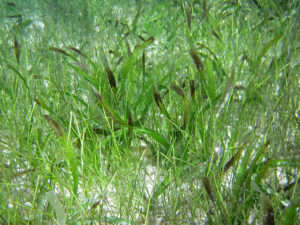
I have grown up in a world where climate change is already reality. Now as a young adult, I watch hurricanes take aim at my home, while my family out west battles wildfires. I know that in my lifetime, climate change will only continue to alter weather patterns and impact my quality of life. However, there are steps that we can take to protect the people and places we love.
One way we can make a difference is to urge our federal legislators to support the Blue Carbon for Our Planet Act.
By Olivia Sciandra
In Florida, there are natural tools in our toolbox to help tackle climate change. Our productive coastal ecosystems, like mangroves, salt marshes and seagrass beds, have incredible carbon sequestration capabilities. The carbon sequestered by coastal and marine ecosystems is called “blue carbon” since it remains in the soil beneath the waves instead of in the atmosphere.
Blue carbon already has been linked to lower levels of ocean acidification in Tampa Bay with healthy seagrasses helping to buck global trends. Another study underway is measuring the ability of those seagrass beds to create “regionally significant refuges” from ocean acidification that already is impacting shellfish in other estuaries.
Coastal ecosystems comprise only 2% of the ocean’s total area but account for nearly half of all carbon being stored in ocean sediments. Protecting and restoring blue carbon ecosystems maintains their carbon sink capacities; however, if they are damaged or degraded, carbon stored in the soil and vegetation is released back into the atmosphere and oceans, further contributing to climate change.
These ecosystems not only sequester carbon but also pump up the economy and protect our coastlines. Here in Tampa Bay, healthy seagrass beds and mangroves create vital nurseries for fish, allowing local fisheries to flourish. Mangroves also protect coastlines against soil erosion and storm surges; worldwide, mangrove ecosystems provide $1.6 billion dollars annually in ecosystem services.
Coastal ecosystems across the country need to be protected from further degradation; those that have been degraded need to be restored. Strategic planning, stewardship, and investment in restoration funding can provide assistance that the Tampa Bay region needs to prepare for sea-level rise and erosion. If Congress passes this legislation, it would be an important step in investing in climate solutions and in our economic prosperity, safeguarding residents on the coast, and protecting the habitats of birds and many native species that rely on coastal ecosystems to thrive.
This bill, introduced by Rep. Suzanne Bonamici (D-OR), will help the United States meet a goal of net-zero carbon emissions by 2050 by leveraging and enhancing the carbon storage benefits of coastal ecosystems. Moreover, the bill would provide the necessary strategic planning and investment in restoration, funding that could help the Tampa Bay region prepare for sea-level rise.
Coastal ecosystems across the US need to be protected from further degradation; those that have been degraded need to be restored. If Congress passes this bill, it will be an important step toward investing in climate solutions and in our economic prosperity, safeguarding residents on the coast, and protecting the habitats of the birds and wildlife that rely on coastal ecosystems to thrive.
![]()
 Olivia Sciandra is a student at the University of South Florida Tampa, working towards a B.S. in environmental biology and a B.A. in anthropology. She is currently involved with West Pasco Audubon Society and is passionate about the conservation of species and the places that they need. She is originally from Las Vegas but has now spent half her life in Florida, mainly in the Tampa Bay area, enjoying all the wonderful natural places the region and Florida have to offer.
Olivia Sciandra is a student at the University of South Florida Tampa, working towards a B.S. in environmental biology and a B.A. in anthropology. She is currently involved with West Pasco Audubon Society and is passionate about the conservation of species and the places that they need. She is originally from Las Vegas but has now spent half her life in Florida, mainly in the Tampa Bay area, enjoying all the wonderful natural places the region and Florida have to offer.
